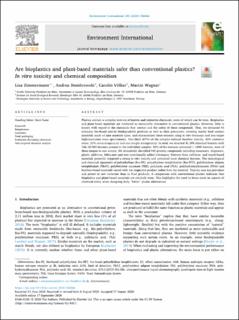| dc.description.abstract | Plastics contain a complex mixture of known and unknown chemicals; some of which can be toxic. Bioplastics and plant-based materials are marketed as sustainable alternative to conventional plastics. However, little is known with regard to the chemicals they contain and the safety of these compounds. Thus, we extracted 43 everyday bio-based and/or biodegradable products as well as their precursors, covering mostly food contact materials made of nine material types, and characterized these extracts using in vitro bioassays and non-target high-resolution mass spectrometry. Two-third (67%) of the samples induced baseline toxicity, 42% oxidative stress, 23% antiandrogenicity and one sample estrogenicity. In total, we detected 41,395 chemical features with 186–20,965 features present in the individual samples. 80% of the extracts contained >1000 features, most of them unique to one sample. We tentatively identified 343 priority compounds including monomers, oligomers, plastic additives, lubricants and non-intentionally added substances. Extracts from cellulose- and starch-based materials generally triggered a strong in vitro toxicity and contained most chemical features. The toxicological and chemical signatures of polyethylene (Bio-PE), polyethylene terephthalate (Bio-PET), polybutylene adipate terephthalate (PBAT), polybutylene succinate (PBS), polylactic acid (PLA), polyhydroxyalkanoates (PHA) and bamboo-based materials varied with the respective product rather than the material. Toxicity was less prevalent and potent in raw materials than in final products. A comparison with conventional plastics indicates that bioplastics and plant-based materials are similarly toxic. This highlights the need to focus more on aspects of chemical safety when designing truly “better” plastic alternatives. | en_US |

